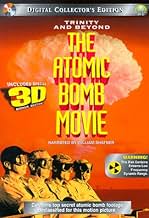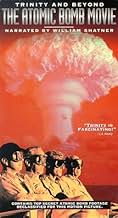The history of nuclear weapons between 1945 until 1963.The history of nuclear weapons between 1945 until 1963.The history of nuclear weapons between 1945 until 1963.
- Awards
- 1 win & 1 nomination total
- Self - Nuclear Physicist
- (as Dr. Edward Teller)
- Self - Commander Joint Task Force One
- (archive footage)
- (as Vice Admiral W.H.P. Blandy)
- Self - Nuclear Weaponeer
- (as Dr. Frank H. Shelton)
- Self - U.S. President
- (archive footage)
- Newsreel Narrator
- (archive sound)
- Self
- (archive footage)
- Self
- (archive footage)
- Self
- (archive footage)
- Self
- (archive footage)
- Self
- (archive footage)
- Daredevil aerialist
- (archive footage)
- Self
- (archive footage)
- Self
- (archive footage)
- Self
- (archive footage)
- Self
- (archive footage)
- Self
- (archive footage)
- Director
- Writers
- All cast & crew
- Production, box office & more at IMDbPro
The picture documents the full scope of American nuclear testing from 1945 to 1963. Sand is fused into glass in New Mexico; islands are literally blown off the map in the South Pacific; a test in space blacks out Honolulu radio. In one nightmarish highlight, a bomb-laden Thor rocket catches fire and explodes on the launch pad. The warhead goes shooting off like a roman candle.
The film makes an interesting bookend to THE ATOMIC CAFE (1982), covering parallel ground, but apolitically, in contrast to the earlier picture's deadpan subversiveness. A key element is the carefully noncommittal narration by William Shatner. It's impossible to know what Shatner thinks about the events he's describing. (Though his direction of STAR TREK V demonstrates that Shatner is something of an expert on bombs.)
On the debit side, the movie feels a few minutes too long, and its Wrath of God musical score, while formidable in small doses, palls a bit as it goes on.
In its wedding of immaculate, surreal visuals with portentious music, TRINITY AND BEYOND oddly reminded me of the New Age films of Ron Fricke - it's like a KOYAANISQATSI for hawks. Sometimes, especially during a few brief shots of domestic animals being locked into cages close to Ground Zero, it makes you want to take a mental bath, at the mixture of intellect and human destructiveness on display. Nonetheless, it's a powerful, intelligent movie that lingers in the memory, and turns a valuable lens on 50's America and the Cold War.
Storyline
Did you know
- TriviaThe soundtrack for this documentary was performed by the Moscow Symphony, and recorded in Moscow. Oddly, this allowed people to view the previously classified material that the former USSR, now Russia, wanted and tried hard to procure it.
- Quotes
Newsreel Narrator: March, 1938. Hitler invades Austria. The Third Reich begins to flex its military muscle. Later that year, German scientists discover fission of the uranium nucleus bringing the Third Reich one step closer to discovering the secret of the atomic bomb. Fear of German research stimulated activity in the United States and England. Fear that German scientists could produce weapons of great devastation. In the fall of 1939, Dr. Albert Einstein wrote his now-famous letter to President Roosevelt, explaining the urgency of work on uranium fission. Roosevelt, a man of action, moved swiftly. An advisory committee on uranium was appointed. German forces invade Poland, plunging the nations of Europe into a second World War. A new branch of the Army's Corps of Engineers was established to administer work on military uses of uranium. Major General Leslie R. Groves, the man in responsible for the Pentagon, was placed in charge of the project. On December 2, the first self-sustaining chain-reacting pile was successfully operated by Enrico Fermi. Fermi's success brought intense efforts between government and the private sector, creating huge industries for uranium separation in the town of Oakridge, Tennessee, and for the production of plutonium in Hanford, Washington at the shores of the mighty Columbia River. This tremendous effort forged the materials necessary for creating an atomic bomb. The first atomic bomb was assembled at Los Alamos, a secret laboratory in New Mexico. When Dr. J.R. Oppenheimer arrived to take charge, he began to surround himself with a galaxy of outstanding scientific stars. From Los Alamos came the bomb design, and treatment of many theoretical problems. Yet many questions still remain unanswered. What are the secrets of this new source of power and destruction? Knowledge and information on all aspects of this new weapon are essential, and can only be discovered by further testing.
- Crazy creditsDedicated to the Air Force 1352nd Motion Picture Squadron Lookout Mountain Laboratory (The Atomic Cinematographers)
- ConnectionsEdited into Atomic Filmmakers: Behind the Scenes (1999)
- SoundtracksWhere the Boys Are
by Neil Sedaka (as Neil Sadaka) and Howard Greenfield
© 1960 renewed 1988 Screen Gems - EMI Music Inc.
and Careers - BMG Music Publishing
All Rights Reserved. International Copyright Secured.
Used By Permission.
Details
- Runtime1 hour 32 minutes
- Color
- Sound mix






































